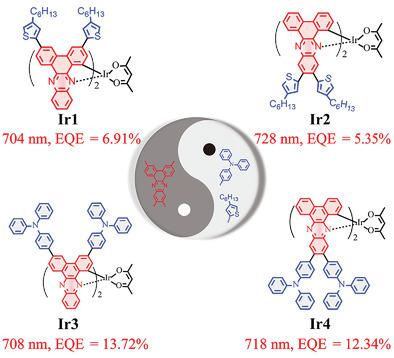当前位置:
X-MOL 学术
›
Adv. Opt. Mater.
›
论文详情
Our official English website, www.x-mol.net, welcomes your feedback! (Note: you will need to create a separate account there.)
Boosting Efficiency of Near‐Infrared Emitting Iridium(III) Phosphors by Administrating Their π–π Conjugation Effect of Core–Shell Structure in Solution‐Processed OLEDs
Advanced Optical Materials ( IF 9 ) Pub Date : 2020-06-22 , DOI: 10.1002/adom.202000154 Caifa You 1 , Denghui Liu 2 , Junting Yu 2 , Hua Tan 2 , Mengbing Zhu 2 , Bin Zhang 2 , Yu Liu 2 , Yafei Wang 2 , Weiguo Zhu 1, 2
Advanced Optical Materials ( IF 9 ) Pub Date : 2020-06-22 , DOI: 10.1002/adom.202000154 Caifa You 1 , Denghui Liu 2 , Junting Yu 2 , Hua Tan 2 , Mengbing Zhu 2 , Bin Zhang 2 , Yu Liu 2 , Yafei Wang 2 , Weiguo Zhu 1, 2
Affiliation

|
High‐efficiency near‐infrared (NIR) phosphorescent emitter is still a great challenge in solution processable organic light‐emitting diodes (OLEDs). Herein, four novel NIR‐emitting iridium(III) complexes with core–shell structure, named as Ir1, Ir2, Ir3, and Ir4, are rationally designed and synthesized, in which the highly rigid dibenzo[a,c] phenazine (DBPz) moiety is used as coordinated core and the flexible hexyl‐thienyl or 4‐(N,N‐diphenylamino)phenyl as peripheral shell anchored in 3, 6‐, or 11, 12‐positions of DBPz. The influence of the core–shell structure on molecular aggregation, photophysical properties, and electroluminescent (EL) performance is systematically investigated. It is found that core–shell structure and substituted positions of shells have great influences on properties of iridium(III) complexes. Intense NIR emissions at 710–740 nm are observed with luminescent quantum yields of 18–30% in these complexes. Solution‐processed NIR‐OLEDs based on Ir3 or Ir4 show better electroluminescent properties. The maximum external quantum efficiency of 13.72% with a radiance of 26 996 mW Sr−1 m−2 (@708 nm) is obtained in Ir3‐doped OLEDs, representing the state‐of‐the‐art EL performance in the iridium complex‐based NIR‐OLEDs. This work demonstrates that administrating π–π conjugation effects of core–shell structure in C^N ligand is a new avenue to obtain high‐efficiency NIR‐emitting iridium(III) complexes.
中文翻译:

通过管理溶液处理的OLED中核-壳结构的π-π共轭效应,提高近红外发射铱(III)荧光粉的效率
高效的近红外(NIR)磷光发射器在可溶液处理的有机发光二极管(OLED)中仍然是一个巨大的挑战。本文中,合理设计和合成了四种具有核-壳结构的新型近红外发射铱(III)络合物,分别命名为Ir1,Ir2,Ir3和Ir4,其中高刚性二苯并[ a,c ]吩嗪(DBPz)部分用作配位核心和柔性己基噻吩基或4-(N,N-二苯基氨基)苯基锚定在DBPz的3、6或11、12位。系统研究了核-壳结构对分子聚集,光物理性质和电致发光(EL)性能的影响。结果发现,核-壳结构和壳的取代位置对铱(III)配合物的性能有很大影响。在这些配合物中,观察到在710–740 nm处的强烈NIR发射,发光量子产率为18–30%。基于Ir3或Ir4的溶液处理NIR-OLED显示出更好的电致发光性能。在Ir3中获得的最大外部量子效率为13.72%,辐射率为26996 mW Sr -1 m -2(@ 708 nm)掺杂的OLED,代表了基于铱配合物的NIR OLED中最先进的EL性能。这项工作表明,在C ^ N配体中管理核-壳结构的π-π共轭效应是获得高效发射NIR的铱(III)络合物的新途径。
更新日期:2020-06-22
中文翻译:

通过管理溶液处理的OLED中核-壳结构的π-π共轭效应,提高近红外发射铱(III)荧光粉的效率
高效的近红外(NIR)磷光发射器在可溶液处理的有机发光二极管(OLED)中仍然是一个巨大的挑战。本文中,合理设计和合成了四种具有核-壳结构的新型近红外发射铱(III)络合物,分别命名为Ir1,Ir2,Ir3和Ir4,其中高刚性二苯并[ a,c ]吩嗪(DBPz)部分用作配位核心和柔性己基噻吩基或4-(N,N-二苯基氨基)苯基锚定在DBPz的3、6或11、12位。系统研究了核-壳结构对分子聚集,光物理性质和电致发光(EL)性能的影响。结果发现,核-壳结构和壳的取代位置对铱(III)配合物的性能有很大影响。在这些配合物中,观察到在710–740 nm处的强烈NIR发射,发光量子产率为18–30%。基于Ir3或Ir4的溶液处理NIR-OLED显示出更好的电致发光性能。在Ir3中获得的最大外部量子效率为13.72%,辐射率为26996 mW Sr -1 m -2(@ 708 nm)掺杂的OLED,代表了基于铱配合物的NIR OLED中最先进的EL性能。这项工作表明,在C ^ N配体中管理核-壳结构的π-π共轭效应是获得高效发射NIR的铱(III)络合物的新途径。


























 京公网安备 11010802027423号
京公网安备 11010802027423号